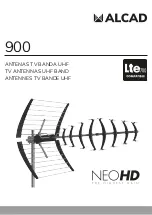
- 3 -
meters will depend in large measure on local earth conductivity, and this may vary considerably
from one place to the next and from one frequency band to the next.
The best procedure is to assume that most earth is a poor conductor over the HF range and that
some radial wires will be needed. Radials may be placed on the surface of the earth or buried
slightly below the surface to get them out of the way, and their length is largely a matter of
convenience. In general, a large number of short radials are preferable to a small number of longer
radials for a given amount of wire, especially if fewer than a dozen radials are to be used. Unlike
resonant radials that must be cut to the proper lengths for use with elevated verticals, ground-level
radials need not to be cut to any particular length; their sole purpose is to provide less lossy return
paths for currents flowing along the earth than the earth itself can provide. And, since "return"
currents will be flowing back to the antenna from all points of the compass, the radial wires should
be spaced uniformly over 360 degrees, although physical circumstances will often make this "ideal"
distribution impossible. For a discussion of ground system for elevated verticals, see the section
entitled "Above Ground Installations" following Checkout and Adjustment instructions.
At a minimum, 20 radials, each 32 feet long, may be used with this
antenna. Using 32 radials at 65 feet long is preferred and highly
recommended for the best performance on 80 meters with this antenna.
The extra radials help overcome unknown poor-soil conditions, improve
bandwidth, and ensure the best performance efficiency possible from the
Butternut HF2V antenna. Radial Wire that is 14 gauge stranded copper
with black relaxed PVC insulation wire is suggested for the best results.
DXE-RADW-32RT
or
65RT
Radial Wire Kits.
The wire radials should be placed as symmetrically as possible straight
from the feedpoint around the vertical antenna and spaced evenly, regardless of how many radials
are used. Do not cross or bunch any radial wires as this nullifies their effectiveness. If you have
limited space, put in as many straight radials as you can. The radials must be connected to the shield
of your feedline. A Radial Plate is the ideal optional item which provides an excellent system for
attaching radial wires to your vertical antenna system.
Radial wires can be laid on the roots of the grass or on bare ground using
Radial Wire Anchor Pins
to hold them down. Using enough staples will ensure the wires will not be snagged by mowers,
people, or animals. Depending on where you live and the type of grass you have, grass will quickly
overgrow the radials and it will be virtually impossible to see them. Radials can also be buried just
under the surface (approximately 1” - anything deeper and you will start losing effectiveness) by
using a power edger to make a slit in the soil.
NOTE:
The function of a ground rod is to place the antenna at D.C. ground potential. It cannot
take the place of an effective RF ground system, such as a number of radial wires, regardless of its
depth in the earth. It does, however, serve as a convenient tie-point for such radials, as does the bolt
through mounting post w/insulator (A) to which radials can be connected by means of the remaining
#8 hardware.


































